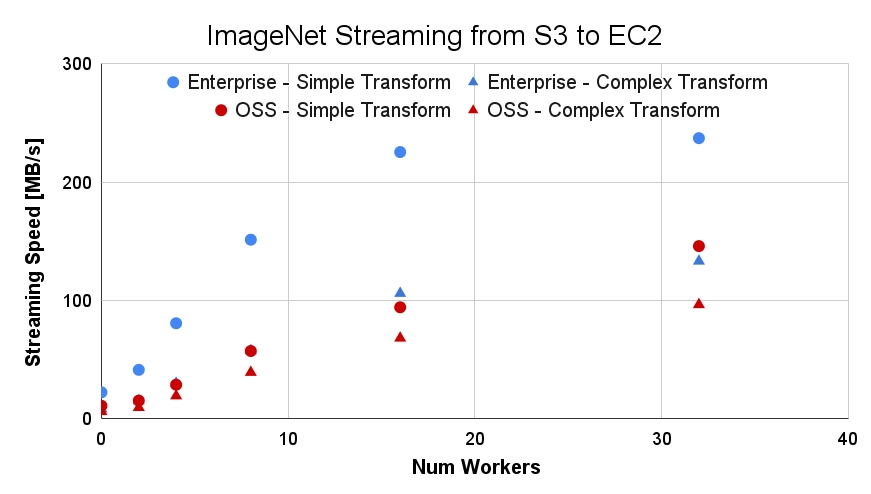Training Models at Scale
Train models at scale using Deep Lake
How to optimize Deep Lake for training models at scale
There are several Deep Lake related tuning parameters that affect the speed of Deep Lake OSS and Performant dataloaders. The plot below shows performance of the Deep Lake dataloaders under different scenarios, and it is discussed in detail below.

Choosing the optimal dataloader
The Deep Lake Performant dataloader streams data faster compared to the OSS dataloaer, due to its C++ implementation that optimizes asynchronous data fetching and decompression.
The Performant dataloader is ~1.5-3X faster compared to the OSS version, depending on the complexity of the transform and the number of workers available for parallelization.
Distributed training is only available in the Performant dataloader.
Setting num_workers
num_workersBoth the OSS and Performant dataloaders in Deep Lake have a num_workers parameter that parallelizes the data fetching, decompression, and transformation.
Increasing
num_workerswill not improve performance in GPU-bottlenecked scenarios. Therefore, we recommend starting with 2-4 workers, and increasingnum_workersit if the GPU utilization is low.Increasing
num_workersbeyond the number of CPUs on a machine does not improve performance.It is common for GPU machines to have 8x CPUs per GPU
Increasing
num_workerslinearly improves streaming speed, with diminishing returns beyond 8+ workers.Increasing
num_workersbeyond 16 is generally unnecessary, unless you are running complex transformations.
Choosing the optimal decode_method for images
decode_method for imagesFaster dataloading is achieved by minimizing the amount of operations that take place before data is delivered to the GPU. It is important to the decode_method parameter in the OSS and Performant dataloaders based on the following guidelines:
When transforming images using tools the require numpy arrays as inputs, such as Albumentations,
decode_methodshould be to numpy, which is the default (No parameters changes are needed)When transforming images using tools the require PIL images as inputs, such as torchvision transforms,
decode_methodshould be to{'image_tensor_name': 'pil'}.torchvision.transforms.ToPIL()should be removed from the top of the transforms stack.Leaving the
decode_methodas numpy may decrease dataloading speed by up to 2X, because the image is decoded to a numpy array and then re-encoded as a PIL image, instead of being directly decoded to a PIL image.
APPENDIX TO THE PLOT ABOVE
The torchvision transforms used to create the comparison in the plot above are:
tform_simple = transforms.Compose(
[
transforms.Resize((128, 128)),
transforms.RandomAffine(20),
transforms.RandomHorizontalFlip(p=0.5),
transforms.ToTensor(),
transforms.Lambda(lambda x: x.repeat(int(3 / x.shape[0]), 1, 1)),
transforms.Normalize([0.485, 0.456, 0.406], [0.229, 0.224, 0.225]),
]
)
tform_complex = transforms.Compose(
[
transforms.Resize((256, 256)),
transforms.RandomAffine(20),
transforms.RandomHorizontalFlip(p=0.5),
transforms.RandomVerticalFlip(p=0.5),
transforms.RandomPerspective(distortion_scale=0.5, p=0.5),
transforms.ColorJitter(brightness=0.2, contrast=0.2, saturation=0.2, hue=0.2),
transforms.ToTensor(),
transforms.Lambda(lambda x: x.repeat(int(3 / x.shape[0]), 1, 1)),
transforms.Normalize([0.485, 0.456, 0.406], [0.229, 0.224, 0.225]),
]
)
Was this helpful?